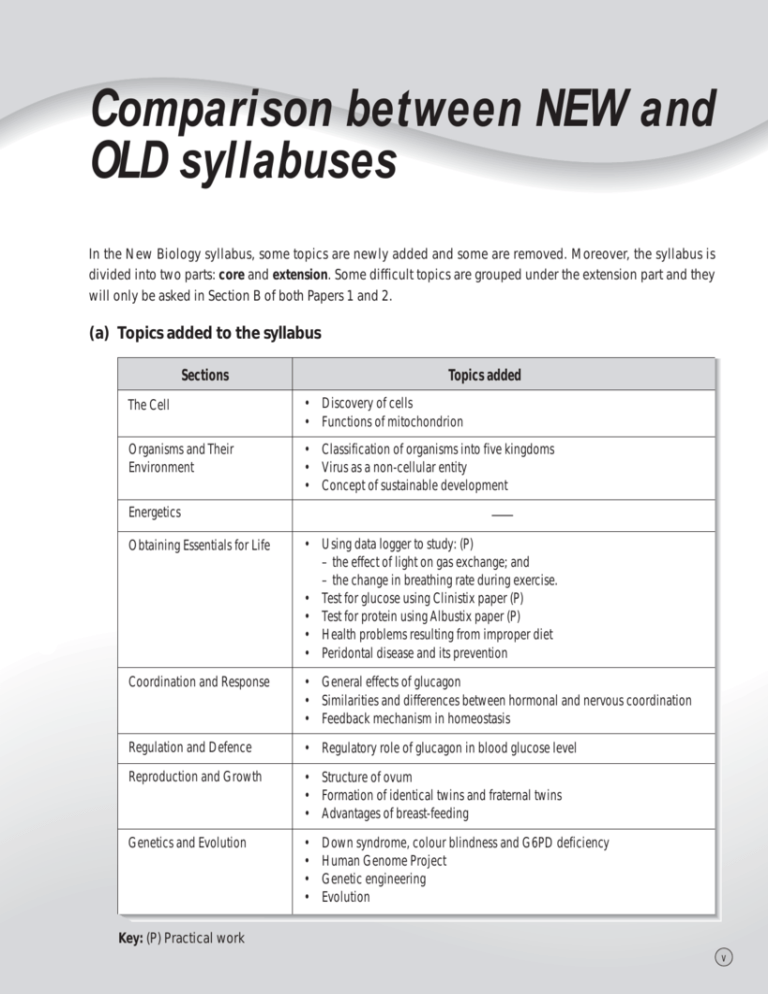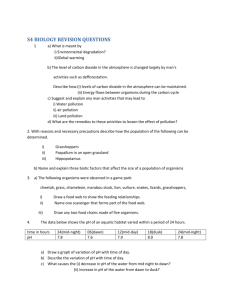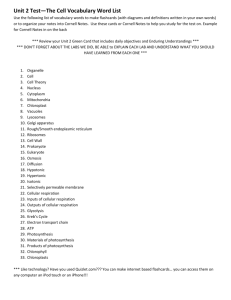
Comparison between NEW and
OLD syllabuses
In the New Biology syllabus, some topics are newly added and some are removed. Moreover, the syllabus is
divided into two parts: core and extension. Some difficult topics are grouped under the extension part and they
will only be asked in Section B of both Papers 1 and 2.
(a) Topics added to the syllabus
Sections
Topics added
The Cell
• Discovery of cells
• Functions of mitochondrion
Organisms and Their
Environment
• Classification of organisms into five kingdoms
• Virus as a non-cellular entity
• Concept of sustainable development
Energetics
—
Obtaining Essentials for Life
• Using data logger to study: (P)
– the effect of light on gas exchange; and
– the change in breathing rate during exercise.
• Test for glucose using Clinistix paper (P)
• Test for protein using Albustix paper (P)
• Health problems resulting from improper diet
• Peridontal disease and its prevention
Coordination and Response
• General effects of glucagon
• Similarities and differences between hormonal and nervous coordination
• Feedback mechanism in homeostasis
Regulation and Defence
• Regulatory role of glucagon in blood glucose level
Reproduction and Growth
• Structure of ovum
• Formation of identical twins and fraternal twins
• Advantages of breast-feeding
Genetics and Evolution
•
•
•
•
Down syndrome, colour blindness and G6PD deficiency
Human Genome Project
Genetic engineering
Evolution
Key: (P) Practical work
v
(b) Topics removed from the syllabus
The following table shows the topics that are removed from the syllabus.
Sections
Topics removed
—
The Cell
Organisms and Their
Environment
Energetics
—
Obtaining Essentials for Life
• Biuret test for protein (P)
• Smoking and health hazards
• Blood groups and blood transfusion
Coordination and Response
• Structure of ear and its auditory function
• Function of ear in detecting movement
• Support in mammal
Regulation and Defence
Reproduction and Growth
Genetics and Evolution
Key: (P) Practical work
vi
• Man and micro-organisms
• Monoculture
—
• Budding in yeast
• Spore formation in Mucor / Rhizopus
• Conditions for seed germination
—
Sections
Topics of the extension part
Practical works
Coordination and
Response
• Causes and corrections of long sight,
short sight
• Causes of colour blindness
• Hormonal coordination in human
• Growth responses of plants
—
Regulation and
Defence
• Feedback mechanism in homeostasis
• Structure, functions and operating
principles of kidney
• Regulation of glucose level in blood
• Principle of vaccination
—
• Examination of model or section of
kidney
—
—
Reproduction and
Growth
• Mitosis and meiosis
• Examination of the processes of
mitosis and meiosis
• Examination of binary fission in
bacteria
• E x a m i n a t i o n a n d c u l t iva t i n g a
propagating organ
• Examination of insect-pollinated
flowers and wind-pollinated flowers
—
• Study of seed germination and growth
of young seedlings
• Asexual reproduction
• Sexual reproduction in flowering
plants
• The advantages of breast-feeding
• Growth and development
Genetics
Evolution
viii
—
—
• Study of phototropic and geotropic
response of plants
• Study of the relative effect of gravity
and water on plant growth
and
• Down syndrome, colour blindness and
G6PD deficiency
• Effects of ionizing radiations and
chemicals on mutation
• Use of genetically modified bacteria in
production of insulin
• Evolution
—
—
—
—
Distribution of Exam
Questions
Year
1993
1994
1995
1996
1997
1998
Chemicals of Life, Cell
and Cell Activities
1a
3ciii
1a
4a
1b
4c
Diversity of Life and
Classification of
Organisms
—
—
—
1ai
3ciii
1(ai-iii)
Ecosystem
—
—
—
2bi, 4 (biiii)
3(ci-ii)
1aiv, 4bii
Man's Effect on the
Environment and
Environmental Protection
4c
2c, 3cii
4c, 3ciii
2biii
3civ
1av, 4(bi,
iii)
Photosynthesis
—
2bi
4(ai-iii)
—
4a
2aii
Respiration
—
1b
—
3c
4(bi-iii)
3c
Nutrition, Gas Exchange,
Water Relation and
Transport in Plants
3b
2(biii), 4c
2(ci, iii),
3(ci-ii)
2a
1a
2(ai-iii)
Nutrition, Gas Exchange
and Transport in Humans
1(ci-ii)
1a, 4(biv,
ciii)
3a
2(cii-v)
1b
4(ci-iv)
Topic
ix
Ecosystem
Section A
1. The diagram shows the feeding relationship between certain
organisms found in a freshwater pond.
Water beetles
Leeches
Hydra
tadpoles
Water snails
Water fleas
Protozoa
Pond weed
Phytoplankton
‘phyto-’ means ‘plant’;
‘plankton’ means ‘microscopic
floating organisms’.
Figure 3.4
(a) Complete the following table which shows the roles of different
organisms in the food web.
Roles in the food web
Organisms
Producer
(i)
Herbivore
(ii)
Omnivore
(iii)
Secondary consumer
(iv)
Table 3.7
Herbivores feed on plants only
while omnivores feed on both
plants and animals.
(4 marks)
(b) The diagram below shows the changes in the population size of
water beetles over a period of time. At point X, the hydras were
removed from the freshwater pond.
X
population
size
time / month
Figure 3.5
59
Photosynthesis
Photosynthesis
• Photosynthesis is a synthetic process occurring in green plants. It converts light
energy into chemical energy in the form of carbohydrates. Oxygen is released as
a by-product.
• The word equation of photosynthesis is:
Carbon dioxide + Water
Light energy
Chlorophyll
Carbohydrate + Oxygen
• The following table shows the four requirements for photosynthesis:
Requirements
Functions
Water
It is a raw material of photosynthesis.
Carbon dioxide
It is a raw material of photosynthesis.
Light
Chlorophyll
It provides energy to drive photosynthesis.
It traps the energy in sunlight and converts it into
chemical energy.
Table 5.1
Processes of photosynthesis
1. Light reaction
H2O
sunlight
• The splitting of water into hydrogen and oxygen by light.
• Chlorophyll is required.
2. Dark reaction
light
reaction
hydrogen oxygen
CO2
• The reduction of carbon dioxide by hydrogen to form carbohydrates. H O
2
carbohydrate
• Chlorophyll is not required.
dark
reaction
95
New Certificate Biology: Conventional Questions 1
Section A
1. (a) Complete the table below which lists the differences between aerobic respiration and anaerobic
respiration taking place in the human body:
Aerobic respiration
Anaerobic respiration
Raw materials
End products
Energy released
(5 marks)
Table 6.9
(b) When a man is doing vigorous exercise, state the type(s) of respiration taking place
(i) in his brain cells. Hint 1
(ii) in his skeletal muscle cells. Hint 2
(1 mark)
(1 mark)
Total: 7 marks
2. The diagram below shows the apparatus designed by a student which is used to study the oxygen
consumption of an insect:
Figure 6.8
(a) Suggest a suitable solution that can be used in the U-tube manometer.
(1 mark)
Hint 3
(b) Describe the change in the liquid level of the U-tube manometer during the experiment.
Explain your answer. Hint 4
(5 marks)
(c) It is argued that the accuracy of the experiment would be easily affected by the environment.
Do you agree with this argument? If yes, suggest two possible environmental factors that
would affect the result of the experiment. Hint 5
(3 marks)
Total: 9 marks
132
CE
BIO
PAPER 1
BIOLOGY PAPER 1
Question-Answer Book
(Mock Examination)
3
1 4 hours
This paper must be answered in English
1. This paper consists of TWO sections, A and B. Section A carries 58 marks, of which 4 marks
are awarded for effective communication. Section B carries 38 marks, of which 2 marks are
awarded for effective communication.
2. Attempt ALL questions in Section A, and any TWO questions in Section B. Write your answers
in the spaces provided in this Question-Answer Book.
3. The diagrams in this paper are not necessarily drawn to scale.
© 2004 Hong Kong Educational Publishing Co.
All rights reserved.
Question Commands
Question Commands
The following table lists the question command(s) which showing the requirements of answering questions:
Question commands
Account for * ...
(Give reasons for, but do NOT
calculate)
Examples
The table below shows the change in total dry mass in seeds before and after
germination:
Total dry mass
Seeds
Seedlings formed
after germination
39.2
28.4
Account for the difference in total dry mass between the seeds and the
seedlings after germination.
Correct answer: Some stored food in the seeds is used in respiration.
Wrong answer: 39.2 g − 28.4 g = 10.8 g
Arrange in ascending order ...
(The lowest first and the highest
last)
Arrange in descending order ...
(The highest first and the lowest
last)
Calculate ...
(Show all the steps of calculation
and give the answer with
appropriate unit)
Arrange the complexity of the following terms in ascending order :
Tissue, cell, system, organ
Correct answer: Cell, tissue, organ, system
Wrong answer: System, organ, tissue, cell
(Remarks: No mark will be awarded for descending order.)
A boy breathes three times per ten seconds, calculate the rate of breathing of
the boy.
Correct answer:
Breathing rate of the boy
3
=
× 60
10
= 18 breaths / min
Wrong answer: Breathing rate = 18
Compare ...
Compare the chromosome number of the sperm with that of the fertilized egg.
(Point out the similarities and / or
differences between two or more
subjects)
Answer: The chromosome number of the sperm is haploid (n) while that of the
fertilized egg is diploid (2n).
Define / What is meant by ...
Define ‘dry weight’ of germinating seedlings.
(State briefly the meaning of the
term)
Answer: The weight of germinating seedlings after removing all of the water
from them.
243
Chemicals of Life, Cell and Cell Activities
1
Chemicals of Life, Cell and Cell Activities
Section A
1. (a) (i) Cell A
(ii) Turgid
1
1
(b) (i) Osmosis
1
(ii) Water comes out from central vacuole of the cell A by osmosis since the
water potential of the surrounding solution is lower.
1+1
Hence, the size of vacuole decreases.
1
As a result, cytoplasm will pull away from the cell wall / the cell becomes
plasmolysed.
1
2. (a) If the land has been flooded with sea water, the soil water will contain a
lot of salt.
The crops will not be able to grow on this land since the concentration of salt
in the soil is too high.
Water will leave the root (hair cells) by osmosis since the water potential of
the soil water is lower.
Hence, causing dehydration of the plant.
1
1
1
1
(b) Diffusion is used to describe the movement of particles of a substance from a
region of higher concentration of particles to a region of lower concentration.
Osmosis is used to describe the movement of solvent / water molecules
from a solution of higher water potential to a solution of lower water potential
through a selectively permeable membrane.
1
1
1
1
3. (a) It is used to transport oxygen.
1
(b) Absence of nucleus
Presence of haemoglobin
1
1
(c) The absence of nucleus provides more space for haemoglobin.
Presence of haemoglobin will increase the oxygen carrying capacity.
1
1
4. (a) The shell of the egg represents the cell wall of a plant cell.
(b) The contents of an egg have a lower water potential than distilled water.
Water enters the egg through the small hole on the shell and the selectively
permeable egg membrane by osmosis, and hence the size of egg white
will expand and break the egg membrane.
The egg white will flow out through the hole.
(c) Cell membrane and cytoplasm
The plasmolysed condition is
normally found in laboratory
conditions; it is extremel
rare in nature. However, th
cell is not harmed by
plasmolysis, it will take u
water again when water is
available.
Transport of materials acros
membranes needs energy.
The energy source for
diffusion and osmosis is the
kinetic energy of particles.
The haemoglobin content is
almost equal to 90% of the
cell s dry mass.
1
1
1
1
1
1+1
Do NOT accept nucleus and
mitochodria as answers.
1









